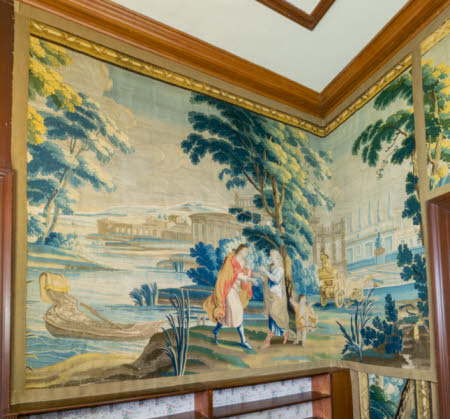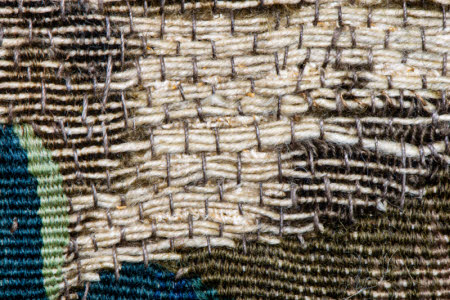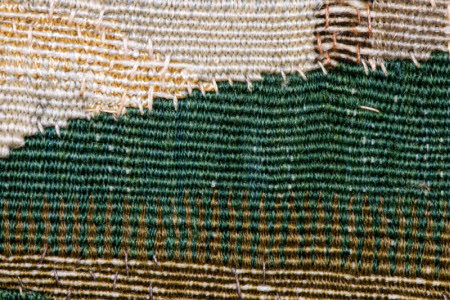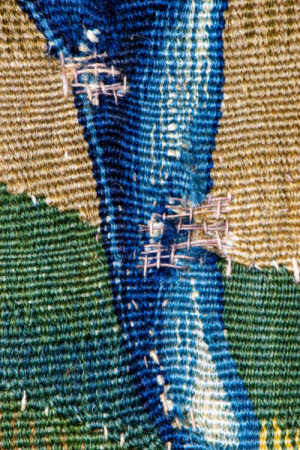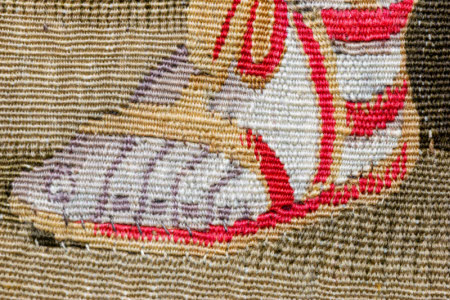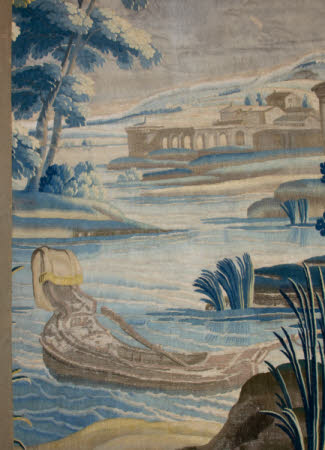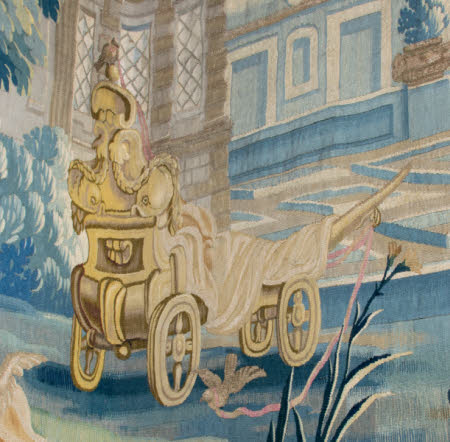Venus and Phaon
probably Antwerp
Category
Tapestries
Date
circa 1680 - circa 1700
Materials
Tapestry, wool and silk, 6 warps per cm
Measurements
2.25 m (H); 3.19 m (W)
Place of origin
Belgium
Order this imageCollection
Vyne Estate, Hampshire
NT 719696.1
Summary
Tapestry, wool and silk, 6 warps per cm, Venus and Phaon from a set of two Stories from Ovid, probably Antwerp, c. 1680-1700. Venus, dressed in a faded cloak over a blue dress, hands a golden box Phaon, a young man wearing a red robe and blue boots. To the right of the couple stands Cupid, winged, with his bow and arrows, pointing to Venus. Venus’s golden chariot stands nearby on the right, with a small bird nearby, and to the left there is a river where a small boat is moored. The scene is a landscape with classical buildings in the background. The tapestry has a narrow border along its upper edge composed of a central pole with crossed ribbons wrapped round it, woven to imitate a carved and gilded picture frame. A wide beige galloon has been applied around all four sides of the tapestry.
Full description
The subject of the tapestry is the meeting of Venus and Phaon. Phaon was an elderly boatman on the island of Lesbos who one day transported an old crone in his ferry, and gave her a free passage out of pity. When they reached the shore the old crone revealed herself to be the goddess Venus in disguise and as a reward for his kindness she gave Phaon a box containing a magical ointment which gave him eternal youth. Many were captivated by Phaon’s youthful beauty, and the myth arose that he shunned the Lesbian poetess Sappho, prompting her to commit suicide by throwing herself from the Leucadian cliffs into the sea. The second tapestry in the Little Tapestry Room at The Vyne represents Sappho (no. 719696.2). The other fragments in the room (nos. 719696.1, 2, 3) all belong to the same set and have probably been removed from the two larger tapestries. The two tapestries of ‘Venus and Phaon’ and ‘Sappho sending her Letter’ (and three related fragments) at The Vyne are part of a larger series of mythological scenes taken from both Ovid’s ‘Metamorphoses’ and his ‘Heroides’. The ‘Heroides’ includes a lament purporting to be written by Sappho on the loss of Phaon, and although Ovid does not relate the meeting of Venus and Phaon the two stories were frequently associated. As many as eleven different subjects have been identified belonging to this series, which may in fact be an amalgamation of two original series: one of the ‘Metamorphoses’ and another of the ‘Story of Sappho’ (Hefford 1983). Hefford notes two further scenes in the series concerning Sappho: one showing her with dishevelled hair and bared breast lamenting Phaon’s departure, and one showing her threatening to leap to her death into the sea from the island of Leucas (Hefford 2010, p. 278). As Koenraad Brosens has observed however, the practices adopted by many late seventeenth-century Flemish weavers, which involved circulating cartoons between different workshops, modifying cartoons by adding or removing figures, and continually amalgamating scenes from different series to customise suites, makes it difficult and often impossible to pinpoint the extent of such mythological tapestry sets (Brosens 2008, p. 203). The origin of the ‘Stories from Ovid’ has been the subject of protracted debate. In the early twentieth century Henry Marillier grouped together almost 100 tapestries with mythological subjects, small figures, and narrow borders like those seen at The Vyne. Since the majority of these tapestries were found in England Marillier speculated that they might be of English origin. Very few of these pieces had marks indicating their origin, and although Marillier found one piece with an English mark, another series at Boughton House had a monogram ‘MW’, which was unknown at the time (Marillier 1930). This monogram was subsequently proved to be that of the Antwerp tapissier Michiel Wauters (Crick-Kuntziger 1935), but Marillier continued to assert that the series was English, based on further examples that appeared on the art market with the English mark (Marillier 1940). Finally Wendy Hefford made an in-depth study of the surviving tapestries and of the documentation relating to the Wauters firm. Hefford concluded that the tapestries now known as ‘Stories from Ovid’ originated with the Wauters firm in Antwerp, whose records mention many of the surviving subjects, but that the designs were subsequently copied by English weavers. Most of the English versions were reversed in relation to the originals, and Hefford also established certain physical criteria for distinguishing between the Antwerp and English versions: in England the red dyes were of a finer quality, and the warp count slightly higher. Based on these criteria the two tapestries at The Vyne are likely to have been made in Antwerp. None of the surviving records of the Wauters ‘Ovid’ tapestries mentions a designer for the set, however Hefford has attributed the design to the little-known Daniel Janssens (1636-1682). Originally from Mechelen (or Malines), a city which traditionally specialised in the production of designs for tapestry, he was registered as a master in the city’s painter’s guild in 1660 and later spent ten years in Antwerp, returning to his native town in around 1675. Janssens produced architectural and decorative works as well as tapestry designs, though little of the former survives. He worked extensively for the Wauters firm and is known to have designed many of their most popular tapestry series including the ‘Seven Liberal Arts’, examples of which survive in the National Trust’s collection at Cotehele (Hefford 1983; Brosens 2008, pp. 199-206) (no. 348261). Another version of ‘Venus and Phaon’, now cut into two pieces, as well as a tapestry of ‘Pygmalion’ from the ‘Stories from Ovid’ series, are also at Cotehele (no. 348258). There are tapestries from the ‘Story of Cadmus’, also part of the larger ‘Stories from Ovid’ group, in the National Trust’s collection at both Lyme Park and Chirk Castle (nos. 500317, 1171318). The early history of the tapestries is unknown but they, like the tapestries ‘after the Indian manner’ (NT 719698) in the neighbouring Tapestry Room at The Vyne, may have been acquired by Edward Chute (1658-1722). (Helen Wyld, 2013)
Provenance
Bequeathed to the National Trust with The Vyne, estate and contents by Sir Charles Chute, 1st Bt (1879-1956)
Makers and roles
probably Antwerp , workshop possibly English, workshop possibly Michel Wauters (d.1679), workshop possibly Wauters, Cockx and de Wael , workshop attributed to Daniel Janssens (Mechelen 1636 - 1682), designer
References
Hefford, 2010: Wendy Hefford, ‘The English Tapestries’, in Guy Delmarcel, Nicole de Reyniès and Wendy Hefford, The Toms Collection Tapestries of the Sixteenth to Nineteenth Centuries, Zürich 2010, pp. 239-294 Brosens, 2008: Koenraad Brosens, European Tapestries in the Art Institute of Chicago, New Haven and London 2008 Hefford, 1983: Wendy Hefford, ‘The Chicago Pygmalion and the “English Metamorphoses”’, The Art Institute of Chicago: Museum Studies, 10 (1983), pp. 93-117 Marillier, 1940: Henry C Marillier, ‘The English Metamorphoses: a confirmation of origin’, Burlington Magazine, vol. 76, no. 443 (Feb. 1940), pp. 60-63 Crick-Kuntziger, 1935: Marthe Crick-Kuntziger, 'Contribution à l'histoire de la tapisserie anversoise: les marques et les tentures des Wauters', in Revue belge d'archéologie et d'histoire de l'art, 5, 1935, pp. 35-44 Marillier, 1930: Henry C Marillier, English Tapestries of the Eighteenth Century, London 1930
